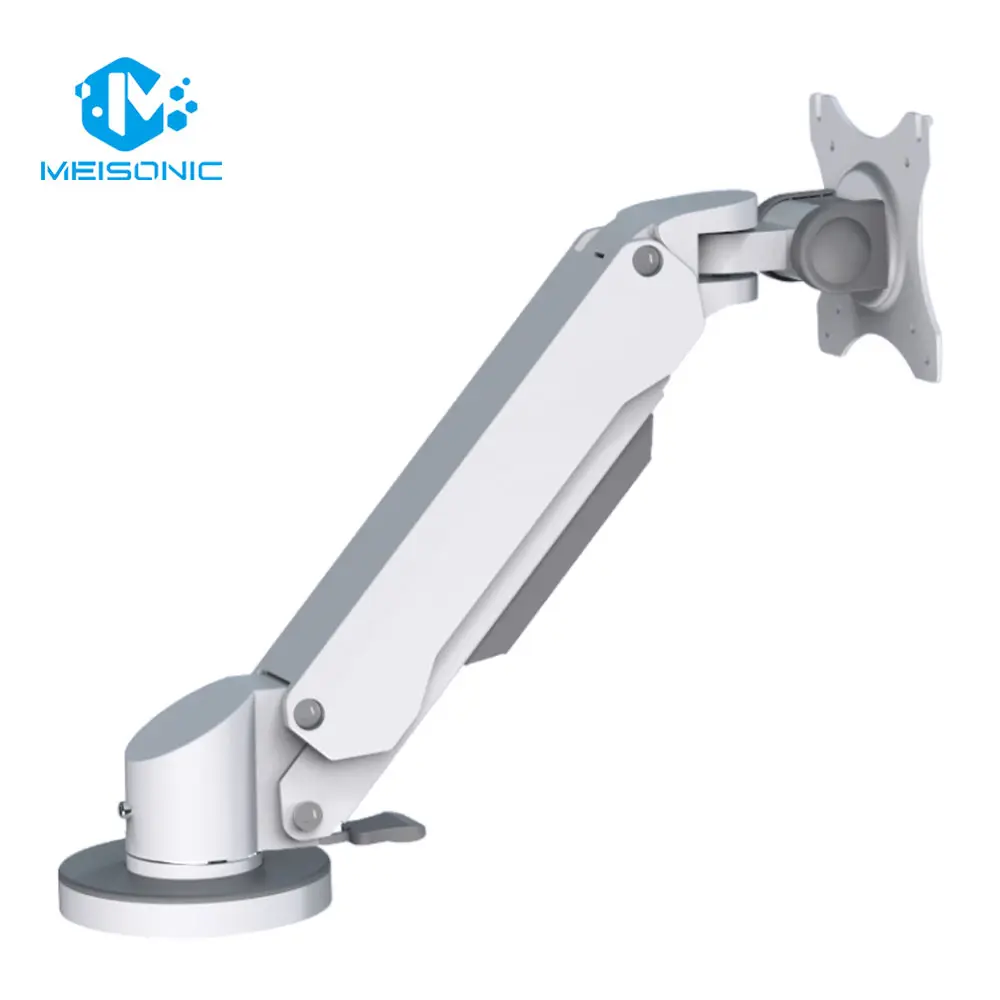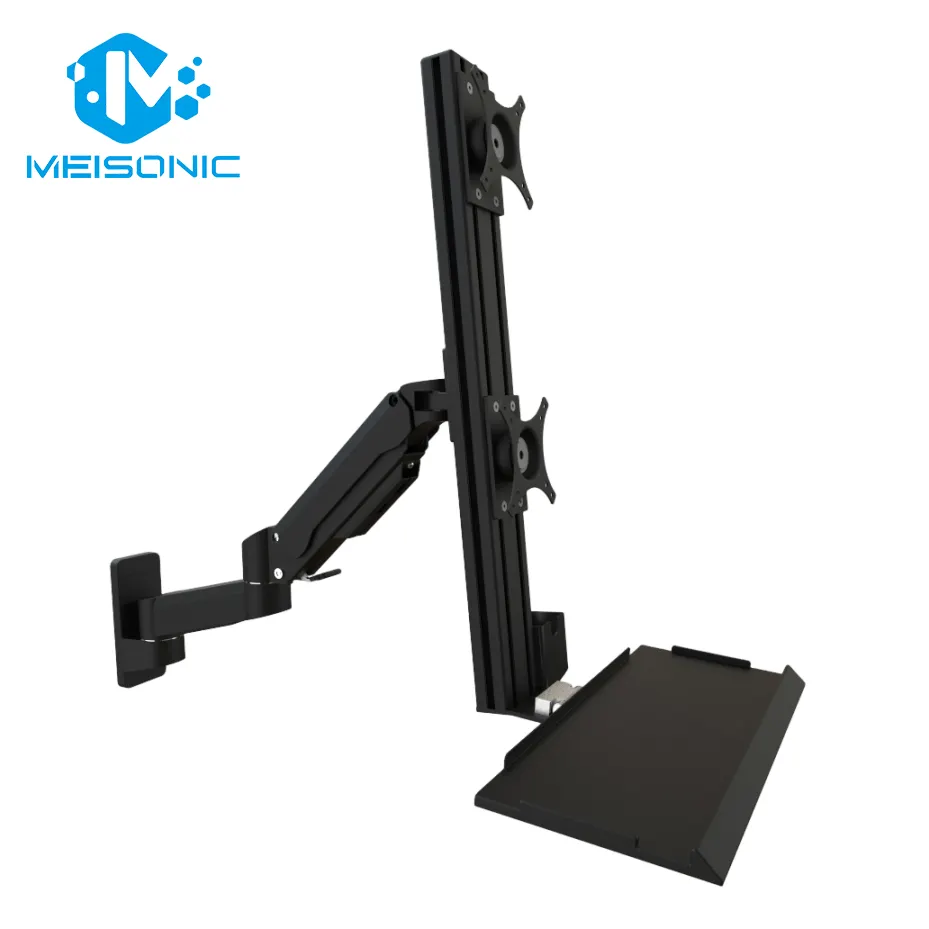Creatio Ambientis Operis Comodi et Efficientis
In hodierno mundo celeri et technologia ducto, retinere commoditatem et efficientiam dum operis magis quam unquam necessaria est. Ad professionales et amatores aeque, bancus operis locus est crucialis ubi productivitas cum creativitate convenit. Integratio brachia monitorem in structuras banci operis transformatum est quemadmodum adpositionem schermi et organisationem spatii laboris aggredimur. Monitoria elevando et adjustmentibus flexibilibus permittendo, arma monitoria caveant ne laboris corporalis intersit dum efficientem processum operis promovant.
Ergonomia propria loci laboris iam non est optio, sed necessaria. Sedere per horas cum positione mala corporis aut cum positionibus fixis schermi potest ducere ad molestiam, fatigationem, etiam ad problemata sanitatis diuturna. Usus brachia monitorem in tuo banco laboratorio permittit meliorem schermi adaptationem, minuendo pericula lesionum ex repetitione et oculorum fatigatione. Haec compositio commoditatis et utilitatis brachia monitoris necessaria facit ad quemlibet qui suis in sedibus laborat.
Meliorans Ergonomiam cum Brachiis Monitoris
Regulando Altitudinem et Angulum Schermi
Unum ex maximis ergonomiae commodis brachiorum monitoris est facultas regelandi altitudinem, inclinationem et conversionem schermi facile. Sine brachiis monitoris, multi homines schermos suos in positione fixa manere, saepe nimis bassos aut altos, creando cervicis et humeri dolorem. Brachia monitoris praebent flexibilitatem ut schermum ad oculorum altitudinem collocare, favens positioni naturali quae musculorum fatigationem minuit.
Brachia monitoris regolabiles etiam permittunt inclinare et rotare schermata ut minimizetur reflexus a fontibus luminis. Haec regolatio non solum oculos a strain protegit, sed etiam claritatem visualem meliorat, quae pro labore minutissimo sicut designatio, programmatio, vel recensio video ad scrinium opus est.
Promovens Positio Neutrale
Positio neutrale clavis est ad prohibenda problemata musculosqueletalia. Brachia monitoris adiuvant uti ne se contrahant aut collo antice plicentur, schermatam in positione optima retinendo. Pro iis qui multas horas in scrinio agunt, haec utilitas dolorem dorsum, colli, et humeri notabiliter minuere potest.
Praeterea, brachia monitoris accommodant usores variis altitudinibus vel iis qui loca communia utuntur, facile schermata reponere pro singulorum commodo. Haec varietas valorem ergonomicae loci laboris augent.

Maximizans Spatium Scrinii cum Brachiis Monitoris
Liberans Praeciosum Spatium Superficialem
Bancus operarius saepe angustus est et congestus instrumentis, machinis, et materiae. Brachia monitoria elevare monitores e superficie scrinii, loca pretiosa liberant aliaque necessaria instrumenta vel opera. Haec effectio expurgandi locum magis ordinatum et operosum creat.
Cum monitoribus in brachiis mutabilibus fixis, utentes instrumenta et machinas suas efficacius disponere possunt. Melior dispositio tempus quaerendi rem quaesitam minuit et opus celerius reddit, faciens sessiones laboris productiviores.
Facilitatio Polytelae et Efficentiae Operis
Professionibus, qui multis tabulis utuntur ad custodiendos diversos datos, formas, vel nuntios, brachia monitoria positionem facilis plurium monitorum sine loci scrinii amissione permittunt. Haec structura polytelae et transitionibus celeribus inter opera succurrit, quae ad efficiens operis bancum necessariae sunt.
Brachia monitoris regolabiles faciunt ut facile interseratur inter modos descriptus et portraictos seu ad inclinandas tabulas pro opere coniuncto. Huiusmodi flexibilitas profectum auget et utentibus permittit suum ambiantem ad necessitudines cuiusque operis aptare.
Promovens diuturnam valetudinem et profectum
Minuens laborem corporalem et lassitudinem
Diuturnae sessiones in banco absque idonea arte ergonomica subsidium possunt ducere ad laborem corporalem et lassitudinem. Brachia monitoris iuvant has insidias minuere idonea tabellarum compositione qua naturalis corporis positura teneatur. Haec compositio musculorum tensionem minuit et prohibet vulgatas molestias ut oculorum laborem et saepe repetitas lesiones.
Movimento et mutatione promovendo, brachia monitoris hortantur utentes ut posituram suam per diem varient. Haec actio variata negat pravos effectus diuturnae sedentis et fixae tabellae positionis.
Augens intentionem et minuens distractions
Idonea monitoris collocatio, quam brachia monitoris adiuvant, etiam concentrationem meliorem et distrahibitiones minores efficit. Cum schermatae ergonomice positionantur, minus molestiae sentiuntur et focus in tenebris diutius retineri potest.
Praeterea, facultas schermatae positionis facile mutandae significat, uti utentes celeriter adiuvare possint apparatus suos ad diversa luminum aut necessitatum condictiones, optimam visionis experientiam retinendo.
Brachiorum Monitoris Recte Eligendorum Causa Tuam Tabulam Operarii
Compatibilitatis et Ponderis Limitum Cognoscendorum Causa
Cum brachia monitoris eligis, necesse est considerare, utrum cum magnitudine et pondere monitoris tui compatibilia sint. Non omnia brachia monitoris magnas aut graves schermatas sustentare possunt, igitur specifica inspicientia tutitudinem et durabilitatem confirmat.
Eligere brachia monitoris quae tuis tabulae operarii figendi optionibus conveniunt, sicut figilla vel foraminis fixiones, stabilitatem et facilitatem installationis quoque iuvat.
De Mote Ratione et Mutationis Facultatibus Cogitando
Diversa brachia monitorum varia spatia motus offerunt. Aliqua plenam articulationem cum altitudine, inclinatione, rotatione et conversione praebent, dum alia motum magis restrictum offerunt. Cognitio tuarum necessitatum et forma tabularii tui adiuvabit determinare optimum typum brachii monitoris.
Brachia monitorum de praecipua qualitate etiam iuncturas leves includunt, quae repositionem sine nimio labore permittunt, quod pro efficentia operis durante sessionibus laboris servanda est.
Consilia de Installatione et Conservatione
Installatio Recta pro Stabilitate et Salute
Installatio recta brachiorum monitorum pro stabilitate et salute usoris necessaria est. Diligenter secutus esse instructiones fabricatoris et certificatus firmum nectendi in tabularium tuum prohibet casus aut damna instrumentorum.
Consilium est periodice examinare compages iuncturae pro firmitate et usu ad fidem brachiorum monitorum tempore servandam.
Mantentio Regularis pro Longaevitate
Brachii monitorum, praesertim qui saepe utuntur, proficiunt ex usu frequente, ut partes mobilis purgentur et unguantur. Haec cura prolongat vitam earum et operacionem sanguineam conservat, praecipue ergonomiam diuturnam.
In Brachii monitorum e materialibus durabilibus investire vim attritionis resistendi augent, eosque ad structuram bancorum tuorum utilem accessionem facit.
FAQ
Quae magnitudo monitoris cum brachiis monitorum optime convenit?
Plurimi brachii monitorum latam magnitudinum seriem sustinent, communiter a 13 ad 32 pollices. Admodum necesse est specifica brachii examinare ut cum magnitudine et pondere tuo monitoris conveniant.
Possuntne brachii monitorum plures monitores in singulis brachiis sustinere?
Ita, sunt brachii monitorum ita facti ut duas aut plures schermas teneant. Hi brachii multiplex schermas spatiolum optimare et processum emendare possunt, singulos monitores exacte locando.
Facilene brachii monitorum in quovis banco installari possunt?
Brachii monitoris plerumque cum optionibus coniunctionis vel clavis praebentur, quae cum pluribus operibenchis congruunt. Attamen, necesse est verificare ut extremitas operibenchii tui firmiter hardware coniunctionis sustinere possit.
Quomodo brachii monitoris adiuvant laborem oculorum minuere?
Permittendo adjustmentem altitudinis, inclinationis, et anguli schermi, brachii monitoris adiuvant monitores ita disponere ut nitorem minuant et distantiam optimalem aspectus servent, laborem oculorum durante usum prolongatum minuentes.





